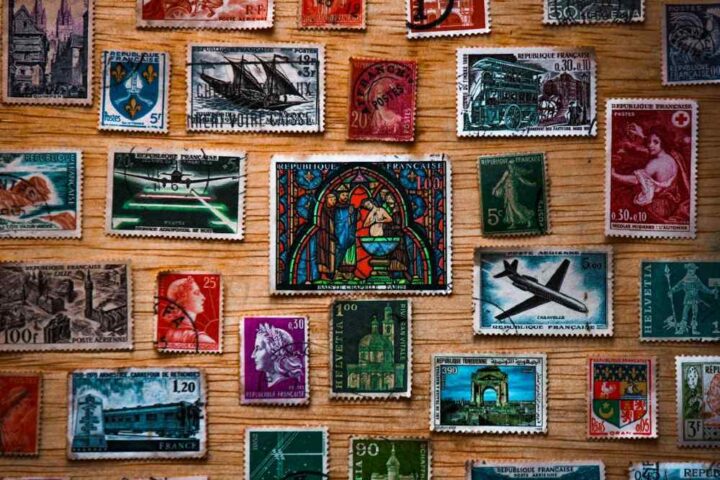The Fascinating World of Postage Stamps: History, Collecting, and Modern Uses
Postage stamps are small pieces of paper that we stick on letters and packages to show we’ve paid to send them. But there’s much more to these tiny rectangles than meets the eye! Let’s explore the interesting world of postage stamps, from how they started to why people collect them and how we use them today.

The Beginning of Postage Stamps
A long time ago, before stamps existed, sending letters was very different. The person getting the letter usually had to pay for it, not the sender. This caused problems because sometimes people didn’t want to pay for the letters they received.
In 1840, a big change happened in England. Rowland Hill came up with the idea of prepaid postage stamps. The first stamp ever made was called the “Penny Black.” It had a picture of Queen Victoria on it and cost one penny. This new system made sending mail easier and fairer for everyone.
How Postage Stamps Spread Around the World
After England started using stamps, other countries quickly followed. Here’s when some countries began using stamps:
1. Brazil – 1843
2. United States – 1847
3. France – 1849
4. Spain – 1850
5. Italy – 1851
By 1860, most countries were using postage stamps. This made sending letters between different countries much simpler.
What’s on a Postage Stamp?
Postage stamps might be small, but they pack a lot of information. Here are some things you might find on a stamp:
1. The country’s name
2. The stamp’s value
3. Pictures or designs
4. Special words or messages
5. The year it was made
Countries often use stamps to show important things about their culture, history, or famous people. For example, you might see stamps with pictures of presidents, beautiful places, or important events.
Why People Collect Stamps
Stamp collecting, also called philately, is a popular hobby. People collect stamps for many reasons:
1. They’re interesting to look at
2. Each stamp tells a story
3. It’s fun to find rare stamps
4. Stamps can teach you about history and culture
5. Some stamps become valuable over time
Famous stamp collectors include Queen Elizabeth II of England and President Franklin D. Roosevelt of the United States.
Types of Stamp Collections
There are many ways to collect stamps. Some people focus on:
1. Stamps from one country
2. Stamps about a certain topic (like animals or sports)
3. Stamps from a specific time period
4. First-Day Covers (special envelopes with new stamps)
5. Rare or valuable stamps
How to Start Collecting Stamps
If you want to start collecting stamps, here are some tips:
1. Decide what kind of stamps you want to collect
2. Get some basic tools like tongs and a magnifying glass
3. Join a stamp collecting club to meet other collectors
4. Learn how to carefully remove stamps from envelopes
5. Keep your stamps safe in a special album
Remember, the most important thing is to have fun with your collection!
Rare and Valuable Stamps
Some stamps are worth a lot of money. Here are a few famous examples:
1. The British Guiana 1c Magenta – This is the most expensive stamp ever sold. In 2014, it was bought for $9.48 million!
2. The Treskilling Yellow – A Swedish stamp with a printing mistake that makes it very rare.
3. The Inverted Jenny – An American stamp where the airplane picture was printed upside down by mistake.
These stamps are so valuable because they’re very rare and have interesting stories behind them.
How Postage Stamps Work Today
Even though we use email and text messages a lot now, postage stamps are still important. Here’s how they work:
1. You buy stamps at the post office or online
2. The stamp’s value shows how much postage you’ve paid
3. You stick the stamp on your letter or package
4. The post office cancels the stamp so it can’t be used again
5. Your mail is delivered to its destination
Different stamps have different values. The price depends on how big your letter or package is and where you’re sending it. For example, postage stamp costs in Australia can vary based on these factors.
Special Types of Modern Stamps
Post offices now make many different kinds of stamps to make mailing more interesting and convenient:
1. Forever Stamps – These always cover the cost of sending a standard letter, even if stamp prices go up.
2. Self-adhesive Stamps – You don’t need to lick these; just peel and stick.
3. Customized Stamps – Some countries let you put your own pictures on stamps.
4. E-stamps – Digital stamps you can print at home.
These new types of stamps make it easier and more fun to send mail.
How Stamps are Made
The process of making stamps is fascinating:
1. Design – Artists create the stamp design
2. Approval – The postal service approves the design
3. Engraving – For some stamps, the design is engraved on a metal plate
4. Printing – The stamps are printed in large sheets
5. Cutting and Packaging – The sheets are cut into individual stamps and packaged
Modern stamps use advanced printing techniques to include security features that prevent counterfeiting.
The Future of Postage Stamps
As we use more digital communication, you might wonder if stamps will disappear. However, many experts think stamps will stick around for a long time. Here’s why:
1. People still send physical mail for special occasions
2. Businesses use stamps for official documents
3. Stamp collecting remains a popular hobby
4. Stamps are a way for countries to share their culture
While stamps might change, they’ll likely continue to be an important part of how we communicate and express ourselves.
Conclusion
Postage stamps might seem simple, but they have a rich history and continue to play an important role in our world. From their beginnings in 1840 to today’s high-tech versions, stamps have always been more than just a way to send mail. They’re tiny windows into the world’s cultures, histories, and values.
Whether you’re interested in collecting stamps, learning from them, or just using them to send a letter to a friend, there’s always something new to discover in the world of postage stamps. Next time you see a stamp, take a moment to appreciate this small but mighty piece of paper. Who knows? You might find yourself joining the millions of people around the world who have fallen in love with the fascinating hobby of stamp collecting!


